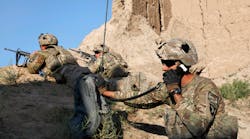No Difference Between Blast- and Non-Blast-Related Concussions In Military Personnel
Explosions are the most-common cause of traumatic brain injuries in veterans returning from Iraq and Afghanistan. A new study from researchers at Washington University School of Medicine in St. Louis shows that military personnel with mild brain trauma related to such blasts had outcomes similar to those with mild brain injury from other causes.
However, nearly 80 percent of patients in both categories of brain trauma suffered moderate to severe overall disability within a year after injury.
The analysis appears in the June 16 issue of JAMA Neurology.
“We are interested in whether there are fundamental differences between the effects of concussions caused by a blast versus other kinds of blunt head trauma,” said senior author David L. Brody, M.D., PhD, associate professor of neurology. “This study and others make us a bit skeptical of the notion that the long-term effects of blast injury to the brain are somehow unique.
“We still think the physics of how a blast interacts with the brain is quite different from other kinds of brain trauma,” he added. “But we have yet to find the consequences of that – if there are any – for patients.”
About 20 percent of U.S. forces in Iraq and Afghanistan are estimated to have experienced a head injury during deployment. Of those injuries, about 83 percent are considered mild forms of traumatic brain injury or concussion.
The researchers examined 255 U.S. military personnel who were injured while on active duty in Iraq and Afghanistan. All were evacuated to Landstuhl Regional Medical Center in Germany.
To assess long-term outcomes, the investigators were able to evaluate 178 patients six to 12 months later. Of these, 53 had mild traumatic brain injury involving an explosion and 29 had mild traumatic brain injury unrelated to a blast. As a comparison, the study also included 27 military personnel with blast exposure (meaning they felt the force of an explosion) but no brain injuries and 69 with no blast exposure who were evacuated for medical reasons other than brain injury.
“For our patients with blast-related concussions, I want to emphasize that the explosion was always in combination with another event, such as a motor vehicle crash, a fall or an object striking the head,” Brody said. “It’s important that we’re mostly studying the combination of blast plus impact, compared to impact alone. Blast injury alone – without a secondary impact – appears to be extraordinarily rare.”
Comparing the two groups with traumatic brain injury (blast- versus non-blast-related), the research team saw no difference in overall disability, with 77 percent of the blast group suffering moderate to severe disability compared with 79 percent of the non-blast group. They also saw no differences between these groups in severity of headaches, depression, post-traumatic stress disorder (PTSD) and performance on cognitive tests. That was despite the fact that the blast-related group reported seeing significantly more active combat.
“In patients with brain injury, combat exposure by itself did not seem to correlate with the high rate of PTSD or depression or the other measures we reported,” Brody said.
Both brain injury groups showed worse overall disability compared with the two control groups evacuated for medical reasons unrelated to concussions. In contrast to the brain injury groups, 59 percent of the blast-without-head-injury group experienced moderate to severe disability as did 41 percent of the group that had experienced no blasts and no head injuries.
The group exposed to a blast without head injury had elevated rates of PTSD and headaches compared with the group with no blasts and no head injuries. But they still were better off than the two groups with head injuries.
“This may suggest an additive effect, where blast exposure and combat exposure combined have some effect, and brain injury on top of that has additional influence on PTSD and other outcome measures,” Brody said.
The investigators, including first author Christine L. MacDonald, PhD, now at the University of Washington in Seattle, also observed that both brain injury groups, even those unexposed to explosions, had much higher rates of disability compared with civilians suffering concussions. To explain these worse outcomes, they note the possibility of active military duty itself playing a role, rather than the physical injury alone.
“Poor outcomes appear to be associated most strongly with having a traumatic brain injury while on active military duty,” Brody said. “It’s also possible these brain injuries in military personnel that resulted in medical evacuation were more severe than we typically see in a civilian population. After a sports-related concussion, for example, many people make a good recovery over several weeks.”
Brody said the researchers’ next step in understanding whether blast-related brain injury is unique is to examine military personnel whose brain injuries were mild enough to allow a return to active duty, a situation that is perhaps more similar to typical civilian concussions.

